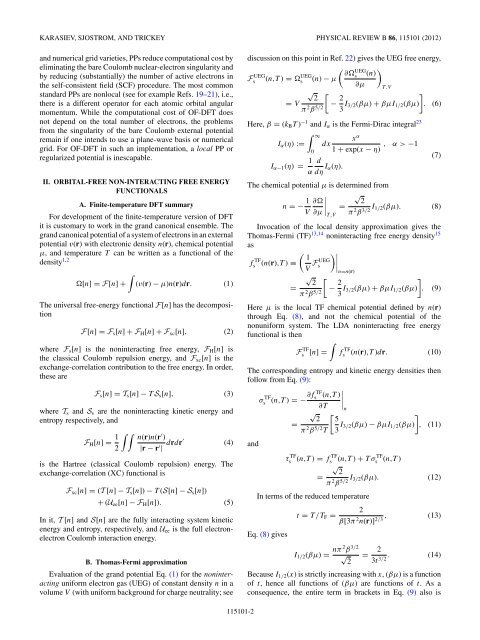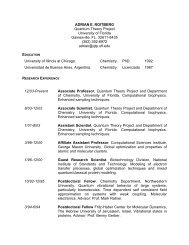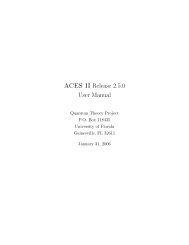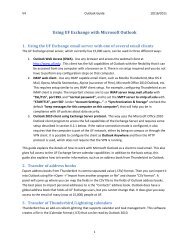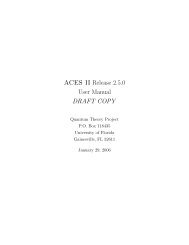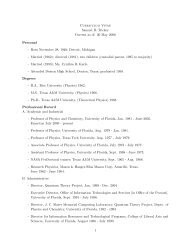Generalized-gradient-approximation noninteracting free-energy ...
Generalized-gradient-approximation noninteracting free-energy ...
Generalized-gradient-approximation noninteracting free-energy ...
You also want an ePaper? Increase the reach of your titles
YUMPU automatically turns print PDFs into web optimized ePapers that Google loves.
KARASIEV, SJOSTROM, AND TRICKEY PHYSICAL REVIEW B 86, 115101 (2012)<br />
and numerical grid varieties, PPs reduce computational cost by<br />
eliminating the bare Coulomb nuclear-electron singularity and<br />
by reducing (substantially) the number of active electrons in<br />
the self-consistent field (SCF) procedure. The most common<br />
standard PPs are nonlocal (see for example Refs. 19–21), i.e.,<br />
there is a different operator for each atomic orbital angular<br />
momentum. While the computational cost of OF-DFT does<br />
not depend on the total number of electrons, the problems<br />
from the singularity of the bare Coulomb external potential<br />
remain if one intends to use a plane-wave basis or numerical<br />
grid. For OF-DFT in such an implementation, a local PP or<br />
regularized potential is inescapable.<br />
II. ORBITAL-FREE NON-INTERACTING FREE ENERGY<br />
FUNCTIONALS<br />
A. Finite-temperature DFT summary<br />
For development of the finite-temperature version of DFT<br />
it is customary to work in the grand canonical ensemble. The<br />
grand canonical potential of a system of electrons in an external<br />
potential v(r) with electronic density n(r), chemical potential<br />
μ, and temperature T can be written as a functional of the<br />
density 1,2 ∫<br />
[n] = F[n] + (v(r) − μ)n(r)dr. (1)<br />
The universal <strong>free</strong>-<strong>energy</strong> functional F[n] has the decomposition<br />
F[n] = F s [n] + F H [n] + F xc [n], (2)<br />
where F s [n] is the <strong>noninteracting</strong> <strong>free</strong> <strong>energy</strong>, F H [n] is<br />
the classical Coulomb repulsion <strong>energy</strong>, and F xc [n] isthe<br />
exchange-correlation contribution to the <strong>free</strong> <strong>energy</strong>. In order,<br />
these are<br />
F s [n] = T s [n] − T S s [n], (3)<br />
where T s and S s are the <strong>noninteracting</strong> kinetic <strong>energy</strong> and<br />
entropy respectively, and<br />
F H [n] = 1 2<br />
∫∫ n(r)n(r ′ )<br />
|r − r ′ | drdr′ (4)<br />
is the Hartree (classical Coulomb repulsion) <strong>energy</strong>. The<br />
exchange-correlation (XC) functional is<br />
F xc [n] = (T [n] − T s [n]) − T (S[n] − S s [n])<br />
+ (U ee [n] − F H [n]). (5)<br />
In it, T [n] and S[n] are the fully interacting system kinetic<br />
<strong>energy</strong> and entropy, respectively, and U ee is the full electronelectron<br />
Coulomb interaction <strong>energy</strong>.<br />
B. Thomas-Fermi <strong>approximation</strong><br />
Evaluation of the grand potential Eq. (1) for the <strong>noninteracting</strong><br />
uniform electron gas (UEG) of constant density n in a<br />
volume V (with uniform background for charge neutrality; see<br />
discussion on this point in Ref. 22) gives the UEG <strong>free</strong> <strong>energy</strong>,<br />
( ∂<br />
Fs<br />
UEG (n,T ) = UEG<br />
UEG<br />
)<br />
s (n)<br />
s (n) − μ<br />
∂μ T,V<br />
√ [ 2<br />
= V − 2 ]<br />
π 2 β 5/2 3 I 3/2(βμ) + βμI 1/2 (βμ) . (6)<br />
Here, β = (k B T ) −1 and I α is the Fermi-Dirac integral 23<br />
∫ ∞<br />
I α (η) := dx<br />
0 1 + exp(x − η) , α > −1 (7)<br />
I α−1 (η) = 1 d<br />
α dη I α(η).<br />
The chemical potential μ is determined from<br />
n =− 1 √<br />
∂<br />
2<br />
V ∂μ∣ =<br />
T,V π 2 β I 1/2(βμ). (8)<br />
3/2<br />
Invocation of the local density <strong>approximation</strong> gives the<br />
Thomas-Fermi (TF) 13,14 <strong>noninteracting</strong> <strong>free</strong> <strong>energy</strong> density 15<br />
as<br />
( )∣ 1 ∣∣∣n=n(r)<br />
fs<br />
TF (n(r),T ) ≡<br />
V F s<br />
UEG<br />
√ [ 2<br />
= − 2 ]<br />
π 2 β 5/2 3 I 3/2(βμ) + βμI 1/2 (βμ) . (9)<br />
Here μ is the local TF chemical potential defined by n(r)<br />
through Eq. (8), and not the chemical potential of the<br />
nonuniform system. The LDA <strong>noninteracting</strong> <strong>free</strong> <strong>energy</strong><br />
functional is then<br />
∫<br />
F TF<br />
s [n] =<br />
x α<br />
f TF<br />
s (n(r),T )dr. (10)<br />
The corresponding entropy and kinetic <strong>energy</strong> densities then<br />
follow from Eq. (9):<br />
σs<br />
TF<br />
TF<br />
∂fs (n,T )<br />
(n,T ) =− ∂T ∣<br />
n<br />
√ [ 2 5<br />
=<br />
π 2 β 5/2 T 3 I 3/2(βμ) − βμI 1/2 (βμ)]<br />
, (11)<br />
and<br />
τ TF<br />
s<br />
(n,T ) = fs<br />
TF (n,T ) + Tσs TF (n,T )<br />
=<br />
In terms of the reduced temperature<br />
Eq. (8) gives<br />
t = T/T F =<br />
√<br />
2<br />
π 2 β 5/2 I 3/2(βμ). (12)<br />
2<br />
, (13)<br />
β[3π 2 n(r)]<br />
2/3<br />
I 1/2 (βμ) = nπ 2 β 3/2<br />
√ = 2 . (14)<br />
2 3t<br />
3/2<br />
Because I 1/2 (x) is strictly increasing with x,(βμ) is a function<br />
of t, hence all functions of (βμ) are functions of t. Asa<br />
consequence, the entire term in brackets in Eq. (9) also is<br />
115101-2


